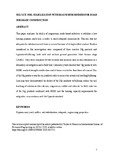Sulphate soil stabilisation with magnesium binders for road subgrade construction
Fecha
2020Autor
Versión
Acceso abierto / Sarbide irekia
Tipo
Artículo / Artikulua
Versión
Versión aceptada / Onetsi den bertsioa
Impacto
|
|
10.1080/10298436.2020.1825711
Resumen
This paper analyzes the ability of magnesium oxide-based additives to stabilise a low bearing gypsum marly soil, in order to reach subgrade requirements. This soil was not adequate for stabilisation with lime or cement because of its high sulphate content. Binders considered in this investigation were composed of three reactive Mg products and by products, both with and without ground granulated ...
[++]
This paper analyzes the ability of magnesium oxide-based additives to stabilise a low bearing gypsum marly soil, in order to reach subgrade requirements. This soil was not adequate for stabilisation with lime or cement because of its high sulphate content. Binders considered in this investigation were composed of three reactive Mg products and by products, both with and without ground granulated blast furnace slags (GGBS). They were compared to two cements and an aerial lime as soil stabilisers in a laboratory investigation and a field trial. Laboratory tests showed that Mg products with GGBS reached strength results close and at times even better than those of cement. One of the Mg products was the only additive able to reduce the natural soil swelling. Leaching tests demonstrated the ability of the Mg products to reduce the soil leaching of substances like calcium, magnesium, sulphate and chloride. In field trials two of the Mg products combined with GGBS met the bearing capacity requirements for subgrades, in accordance with the Spanish standard. [--]
Materias
Gypsum marly soil,
Sulphate,
Soil stabilisation,
Subgrade,
Engineering properties
Editor
Taylor and Francis
Publicado en
International Journal of Pavement Engineering, 2020
Departamento
Universidad Pública de Navarra. Departamento de Ingeniería /
Nafarroako Unibertsitate Publikoa. Ingeniaritza Saila /
Universidad Pública de Navarra/Nafarroako Unibertsitate Publikoa. Institute of Smart Cities - ISC
Versión del editor
Entidades Financiadoras
This work was supported by Gobierno de Navarra and Fondo Europeo de Desarrollo Regional [grant number 0011-1365-2018-000093].





